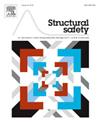Modeling probabilistic micro-scale wind field for risk forecasts of power transmission systems during tropical cyclones
IF 6.3
1区 工程技术
Q1 ENGINEERING, CIVIL
引用次数: 0
Abstract
Tropical cyclones (TCs) pose significant risks to power transmission systems, causing extensive damage, widespread outages and severe socio-economic impacts. While reliable risk forecasting of these systems during TCs hinges on accurate wind predictions, operational numerical weather prediction (NWP) models struggle to deliver unbiased, high-resolution probabilistic wind-field forecasts necessary for infrastructure risk projections. This study introduces the Probabilistic Micro-Scale Wind-Field model (ProbMicro-WF) designed to enhance real-time hazard modeling for power system risk forecasts during TC evolution. This model improves NWP wind forecast by achieving the following: 1) probabilistic calibration and bias correction for NWP wind forecasts, leveraging historical TC observational data to improve prediction accuracy at high wind speeds; 2) terrain-modified statistical downscaling that translates mesoscale forecasts to micro-scale wind fields, capturing localized wind dynamics critical for tower- and transmission line-specific risk evaluation; and 3) a spatiotemporal stochastic model that preserves wind-field correlation structures, mitigating systemic underestimation of risk variance across geographically dispersed infrastructure during TC evolution. Finally, the ProbMicro-WF model is applied to the power transmission system in Zhejiang Province, China (105,500 km2) during Super Typhoon Lekima in 2019, highlighting its capability to simulate spatially coherent, high-resolution wind fields, enabling robust pre-event mitigation and real-time grid management in TC-prone regions.
热带气旋期间输电系统风险预报的概率微尺度风场建模
热带气旋(tc)对输电系统构成重大风险,造成广泛破坏、大范围停电和严重的社会经济影响。虽然这些系统在tc期间的可靠风险预测取决于准确的风力预测,但操作性数值天气预报(NWP)模型难以提供基础设施风险预测所需的无偏、高分辨率概率风场预测。本文介绍了概率微尺度风场模型(ProbMicro-WF),该模型旨在增强电力系统在TC演变过程中风险预测的实时风险建模。该模型通过实现以下几点改进了NWP风预报:1)NWP风预报的概率校正和偏置校正,利用历史TC观测数据提高了高风速下的预报精度;2)地形修正统计降尺度,将中尺度预报转化为微尺度风场,捕捉局部风动力学,对塔和输电线路特定风险评估至关重要;3)一个时空随机模型,该模型保留了风场相关结构,减轻了在TC演化过程中地理分散的基础设施风险方差的系统性低估。最后,将ProbMicro-WF模型应用于2019年超级台风“利基马”期间中国浙江省(105,500平方公里)的输电系统,突出了其模拟空间相干、高分辨率风场的能力,从而在tc易发地区实现了强大的事件前缓解和实时电网管理。
本文章由计算机程序翻译,如有差异,请以英文原文为准。
求助全文
约1分钟内获得全文
求助全文
来源期刊

Structural Safety
工程技术-工程:土木
CiteScore
11.30
自引率
8.60%
发文量
67
审稿时长
53 days
期刊介绍:
Structural Safety is an international journal devoted to integrated risk assessment for a wide range of constructed facilities such as buildings, bridges, earth structures, offshore facilities, dams, lifelines and nuclear structural systems. Its purpose is to foster communication about risk and reliability among technical disciplines involved in design and construction, and to enhance the use of risk management in the constructed environment
 求助内容:
求助内容: 应助结果提醒方式:
应助结果提醒方式:


